| KHMER Influence | LANNA Period | SUKHOTHAI Period |
| AYUTTHAYA Period | THONBURI Period | RATTANAKOSIN Period |
Origin of Thais
 Thailand (previously known as Siam) has been populated ever since the dawn of civilization in Asia. There are
conflicting opinions of the origins of the Thais. It presumed that about 4,500 years.
Thais originated in northwestern Szechuan in China and later migrated down to Thailand along the southern part of China. They split into two main groups. One settled down in the North and became the kingdom of
"Lanna" and the other one is in further south, which afterward was defeated by the Khmers and became the kingdom of "Sukhothai".
Thailand (previously known as Siam) has been populated ever since the dawn of civilization in Asia. There are
conflicting opinions of the origins of the Thais. It presumed that about 4,500 years.
Thais originated in northwestern Szechuan in China and later migrated down to Thailand along the southern part of China. They split into two main groups. One settled down in the North and became the kingdom of
"Lanna" and the other one is in further south, which afterward was defeated by the Khmers and became the kingdom of "Sukhothai".
There are conflicting opinions as to the origins of the Thais. Three
decades ago it could be said with presumed certainty that the
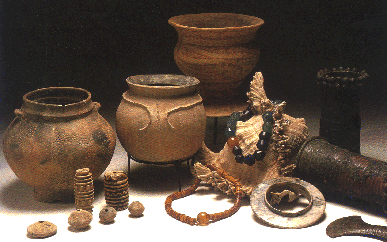 Thais originated
in the southern part of what is now China about 4,500 years ago. Recently,
however, this theory has been altered by the discovery of prehistoric
artifacts
in the village of Ban Chiang in the Nong Han District of UdonThani province in the
Northeast. From these evidence of bronze metallurgy going back 3,500 years, as well as other indication of a far
more sophisticated culture than any previously suspected by
archaeologists.
It now appears that the Thais might have originated here in Thailand and later scattered to various parts of Asia, including China.
Thais originated
in the southern part of what is now China about 4,500 years ago. Recently,
however, this theory has been altered by the discovery of prehistoric
artifacts
in the village of Ban Chiang in the Nong Han District of UdonThani province in the
Northeast. From these evidence of bronze metallurgy going back 3,500 years, as well as other indication of a far
more sophisticated culture than any previously suspected by
archaeologists.
It now appears that the Thais might have originated here in Thailand and later scattered to various parts of Asia, including China.
The controversy over the origin of the Thais shows no sign of definite conclusion as many more theories have been put forward and some even go further to say that Thais were originally of Austronesian rather than Mongoloid. What the outcomes of the dispute may be, by the 13th century the Thais had already settled down within the southeast Asia.
Khmer Influence
 From the 9th to the 11th century, the central and western area of Thailand was occupied by Mon civilization called Dvaravati. The Mon share the same common lineage as the Khmers and settle in southern Burma latter. The Influence of Dvaravati include Nakhon Pathom, Khu Bua, Phong Tuk , and Lawo
(Lopburi). Dvaravati was Indianized culture, Theravada Buddhism was remained the major religion in this area.
From the 9th to the 11th century, the central and western area of Thailand was occupied by Mon civilization called Dvaravati. The Mon share the same common lineage as the Khmers and settle in southern Burma latter. The Influence of Dvaravati include Nakhon Pathom, Khu Bua, Phong Tuk , and Lawo
(Lopburi). Dvaravati was Indianized culture, Theravada Buddhism was remained the major religion in this area.
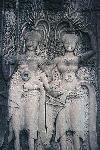
By the 11th-12th centuries, Mon Influenced over central Thailand. Khmer cultural influence was brought in the form of language, art and religion. The
"Sanskrit" language was entered in Mon-Thai vocabulary during the Khmer or Lopburi Period. The influence of this period has affected many provinces in the north-east such as Kanchanaburi and Lopburi. The Architecture in "Angkor" was also constructed according to the Khmers style. The Khmer built stone temples in the northeast, some of which have been restored to their former glory, those at Phimai and Phanom Rung and further cultures are stone sculptures and stone Buddha
images. Politically, however, the Khmer cultural dominance did not control the whole area but power through vassals and governors.
Lanna Period
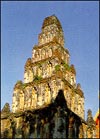 Northern
Thailand was once occupied by the ancient Lanna Empire, which spread over Chiang Mai,
Lampang, Lamphun and Phayao. Tucked comfortably in a valley, Chiang Mai - Lamphun and Chiang Rai - Phayao represented the two main
plateaus of the empire. Known as Haripunchai, Chiang Mai - Lamphun subsequently expanded to include Kelang
Nakhon, or Lampang. Meanwhile, Chiang Rai - Payao in those days was known as
Yonok.
Northern
Thailand was once occupied by the ancient Lanna Empire, which spread over Chiang Mai,
Lampang, Lamphun and Phayao. Tucked comfortably in a valley, Chiang Mai - Lamphun and Chiang Rai - Phayao represented the two main
plateaus of the empire. Known as Haripunchai, Chiang Mai - Lamphun subsequently expanded to include Kelang
Nakhon, or Lampang. Meanwhile, Chiang Rai - Payao in those days was known as
Yonok.
The chronicles of the origin of "Lan Na" to "Chiang Saen" lies on the Mae Kong River. Its first leader named "King Mengrai",
ascended to the throne in 1259. He extended the kingdom from the borders of Laos to Lamphum.
According to an ancient inscription, Haripunchai was seized by Phraya Mengrai, who then built Chiang Mai as hiskingdom's capital. The
construction, which started in
B.E. 1839 (1296 A.D.) was witnessed by Phya Ngum Muang of Phayao and Phra Ruang of
Sukhothai. Apparently, the three kings were close friends and their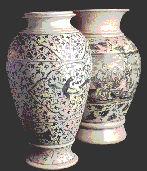 kingdoms were so closely related that
they were like a consolidated nation. Territorial boundaries made no difference to the peoples of the three kingdoms, Who enjoyed an exceptionally active trade
relations. As a memorial to such friendly links, a monument of the three kings was built and they now stand immortalized in front of the Chiang Mai City Hall.
kingdoms were so closely related that
they were like a consolidated nation. Territorial boundaries made no difference to the peoples of the three kingdoms, Who enjoyed an exceptionally active trade
relations. As a memorial to such friendly links, a monument of the three kings was built and they now stand immortalized in front of the Chiang Mai City Hall.
Lan Na flourished for over 200 years. Its arts and literature rose at the peak, especially in the middle of 15th century,
the King Tilokoraj period. Chiang Mai in this period was also chosen as the navel of the eight world synod of Theravada
Buddhism.
After the death of King Tilokoraj, the kingdom suffered from internal conflicts. Lan
Na weakened because of wars with
Sukhothai's successors.
Sukhothai Period
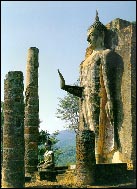 Sukhothai, meaning the ''Dawn of Happiness''
was the first truly independent Thai Kingdom founded in 1238, by two Thai
chieftains, Khun Bang Klang Tao and Khun Pa Muang , this ending Khmer rule from
Angkor Wat. In the early 1300s, Sukhothai enjoyed rule over the Chao Phya
River basin, westward to the bay of Bengal and the entire Peninsula. A kingdom that was short-lived but of immense cultural importance in the nation’s history. Sukhothai period was the most flourishing period of Thailand. It
quickly expanded its boundary of influence after
independence. Sukhothai period was considered to be a golden age of Thai culture. During that time in the history, everybody could say that "There
were fish in the waters and rice in the fields".
Sukhothai, meaning the ''Dawn of Happiness''
was the first truly independent Thai Kingdom founded in 1238, by two Thai
chieftains, Khun Bang Klang Tao and Khun Pa Muang , this ending Khmer rule from
Angkor Wat. In the early 1300s, Sukhothai enjoyed rule over the Chao Phya
River basin, westward to the bay of Bengal and the entire Peninsula. A kingdom that was short-lived but of immense cultural importance in the nation’s history. Sukhothai period was the most flourishing period of Thailand. It
quickly expanded its boundary of influence after
independence. Sukhothai period was considered to be a golden age of Thai culture. During that time in the history, everybody could say that "There
were fish in the waters and rice in the fields".
The boundary of Sukhothai stretched from Lampang in the north to Vientiane, in present day Laos and the south to the Malay Peninsula.
Sukhothai saw the Thais’ gradual expansion throughout the entire Chao Phraya River basin and the establishment of
Theravada Buddhism as the paramount Thai religion. During this time Thai had strong friendship with neighboring countries. It
absorbed elements of various civilizations which they came into contact. Thai maintained and advanced their culture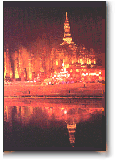 ties with China. The potters entered Thai artistry and extensive trade was established with Cambodia and India.
ties with China. The potters entered Thai artistry and extensive trade was established with Cambodia and India.
After the death of Khun Pha Muang in 1279, Ramkhamhaeng King, the third son of Si Inthrahit, ascended to the throne. Under the Ramkhamhaeng King, Sukhothai had strong friendship with neighboring China. King Ramkhamhaeng organized a writing system which became the basis for writing and eventually developed to be the modern Thai alphabet. It was here that the first evidence of written Thai was left, along with distinctively Thai styles of art such as painting, sculpture, architecture and literature, which survived after Sukhothai was absorbed by the kingdom of Ayutthaya – a dynamic young kingdom further south in the Chao Phraya River valley.
Ayutthaya Period
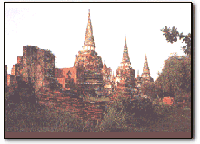 For 417 years the kingdom of Ayutthaya was the dominant power in the fertile
Menam or Chao Phraya Basin. Its capital was Ayutthaya, an island-city situated
at the confluence of three rivers, the Chao Phraya, the Pasak, and the Lopburi,
which grew into one of Asia's most renowned metropolises, inviting comparison
with great European cities such as Paris. The city must indeed have looked
majestic, filled as it was with hundreds of monasteries and crisscrossed with
several canals and waterways which served as roads.
For 417 years the kingdom of Ayutthaya was the dominant power in the fertile
Menam or Chao Phraya Basin. Its capital was Ayutthaya, an island-city situated
at the confluence of three rivers, the Chao Phraya, the Pasak, and the Lopburi,
which grew into one of Asia's most renowned metropolises, inviting comparison
with great European cities such as Paris. The city must indeed have looked
majestic, filled as it was with hundreds of monasteries and crisscrossed with
several canals and waterways which served as roads.
Ayutthaya, the capital of the Thai Kingdom was found by U-Thong King in 1350. Ayutthaya as an island is formed by the gathering of three rivers, the Chao Phraya, the Pasak, and the Lopburi and surrounded by rice terraces. It is easy to see why the Ayutthaya area was settled prior to this date since the site offered a variety of geographical and economic advantages. Not only is Ayutthaya at the confluence of three rivers, plus some canals, but its proximity to the sea also gave its inhabitants an irresistible stimulus to engage in maritime trade. The rice fields in the immediate environs flooded each year during the rainy season, rendering the city virtually impregnable for several months annually. These fields, of course, had an even more vital function, that of feeding a relatively large population in the Ayutthaya region. Rice grown in these plants yielded a surplus large enough to be exported regularly to various countries in Asia.
The Thai kings of Ayutthaya became powerful in the 14th and 15th centuries, taking over U-Thong, Lopburi, and Ayutthaya. Ayutthaya's first king, Ramathibodi I, was both a warrior and a lawmaker. Some old laws codified in 1805 by the first Bangkok king date from this much earlier reign. King Ramathibodi I and his immediate successors expanded Ayutthaya's territory, especially northward towards Sukhothai and eastward towards the Khmer capital of Angkor. By the 15th century, Ayutthaya had established a firm hegemony over most of the northern and central Thai states, though attempts to conquer Lanna failed. Ayutthaya also captured Angkor on at least one occasion but was unable to hold on to it for long. The Ayutthaya kingdom thus changed, during the 15th century, from being a small state primus inter pares among similar states in central Thailand into an increasingly centralized kingdom wielding tight control over a core area of territory, as well as having looser authority over a string of tributary states.
King U-Thong and his immediate successors expanded Ayutthaya's territory, especially northward towards Sukhothai and eastward towards the Khmer capital of Angkor. The greater size of Ayutthaya's territory, as compared with that of Sukhothai, meant that the method of government could not remain the same as during the days of King Ramkhamhaeng. The paternalistic and benevolent Buddhist kingship of Sukhothai would not have worked in Ayutthaya. The king of the latter therefore created a complex administrative system allied to a hierarchical social system. This administ rative system dating from the reign of King Trailok, or Borommatrailokanat(1448-1488), was to evolve into the modern Thai bureaucracy. The Ayutthaya bureaucracy contained a hierarchy of ranked and titled officials, all of whom had varying amounts of "honor marks" (sakdina).Thai society during the Ayutthaya period also became strictly hierarchical. There were, roughly, three classes of people, with the king at the very apex of the structure. At the bottom of the social scale, and the most numerous, were the commoners (freemen or phrai) and the slaves. Above the commoners were the officials or "nobles" (khunnang), while at the top of the scale were the princes (chao). The one classless sector of Thai society was the Buddhist monkhood, or sangha, into which all classes of Thai men could be ordained. The monkhood was the institution which could weld together all the different social classes, the Buddhist monasteries being the center of all Thai communities both urban and a gricultural.
The Ayutthaya kings were not only Buddhist kings who ruled according to the
dhamma (dharma), but they were also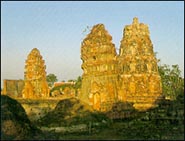 devaraja, god-kings whose
sacred power was associated with the Hindu, gods Indra and Vishnu. To many
Western observers, the kings of Ayutthaya were treated as if they were gods. The
French Abbe de Choisy, who came to Ayutthaya in 1685, wrote that, "the king
has absolute power. He is truly the god of the Siamese: no-one dares to utter
his name." Another 17th century writer, the Dutchman Van Vliet, remarked
that the king of Siam was "honoured and worshipped by his subjects more
than a god.
devaraja, god-kings whose
sacred power was associated with the Hindu, gods Indra and Vishnu. To many
Western observers, the kings of Ayutthaya were treated as if they were gods. The
French Abbe de Choisy, who came to Ayutthaya in 1685, wrote that, "the king
has absolute power. He is truly the god of the Siamese: no-one dares to utter
his name." Another 17th century writer, the Dutchman Van Vliet, remarked
that the king of Siam was "honoured and worshipped by his subjects more
than a god.
The Ayutthaya period was early Thai history's great era of international trade.
Ayutthaya's role as a port made it one of Southeast Asia's richest emporia. The
port of Ayutthaya was an entrepot, an international market place where goods
from the Far East could be bought or bartered in exchange for merchandise from
the Malay/Indonesian Archipelago, India, or Persia, not to mention local wares
or produce from Ayutthaya's vast hinterland. The trading world of the Indian
Ocean was accessible to Ayutthaya through its possession, for much of its
417-year history, of the seaport of Mergui on the Bay of Bengal. This port in
Tenasserim province was linked to the capital by a wild but ancient and
frequently used overland trade route.
Throughout its long history, Ayutthaya had a thriving commerce in "forest produce", principally sapanwood (a wood which produces reddish dye), eaglewood (an aromatic wood), benzoin (a type of incense), gumlac (used as wax), and deerhides (much in d emand in Japan). Elephant teeth and rhinoceros horns were also highly valued exports, but the former was a strict royal monopoly and the latter relatively rare, especially compared with deerhides. Ayutthaya also sold provisions such as rice and dried fish to other Southeast Asian states. The range of minerals found in the kingdom was limit ed, but tin from Phuket ("Junkceylon") and Nakhon Si Thammarat ("Ligor") was much sought after by both Asian and European traders.
The Chinese, with their large and versatile junks, were the traders who had the most regular and sustained contact with Ayutthaya. The Ayutthaya kings, in order to conduct a steady and profitable trade with Ming and Manchu China, from the 14th to t he 18th centuries, entered willingly into a tributary relationship with the Chinese emperors. The Thais recognized Chinese suzerainty and China's preeminent position in Asia in return for Chinese political sanction and, even more desirable, Chinese luxury goods. Muslim merchants came from India and further West to sell their highly-prized clothes both to Thais and to other foreign traders. So dominant were Chinese and Muslim merchants in Ayutthaya that an old Thai law dating back to the 15th century divides the Thai king's foreign trade department into two: a Chinese section and a Muslim section. Chinese, Indians, and later on Japanese and Persians all settled in Ayutthaya, the Thai kings welcoming their presence and granting them complete freedom of worship. Several of these foreigners became important cour t officials.
Containing merchandise from all corners of Asia, the thriving markets of Ayutthaya attracted traders from Europe. The Portuguese were the first to arrive, in 1511, at the time when Albuquerque was attempting to conquer Melaka (Malacca). They conclu ded their first treaty with Ayutthaya in 1516, receiving permission to settle in Ayutthaya and other Thai ports in return for supplying guns and ammunition to the Thai king. Portugal's powerful neighbor Spain was the next European nation to arrive in Ayutthaya, towards the end of the 16th century. The early 17th century saw the arrival of two northern European East India Companies: The Du tch (V.O.C) and the British. The Dutch East India Company played a vital role in Ayutthaya's foreign trade from 1605 until 1765, succeeding in obtaining from the Thai kings a deerhide export monopoly as well as one of all the tin sold at Nakhon Si Thammarat. The Dutch sold Thai sapanwood and deerhides for good profits in Japan during Japan's exclusion period, after 1635.
The French first arrived in 1662, during the reign of Ayutthaya's most outward-looking and cosmopolitan ruler, King Narai (1656-1688). French missionaries and merchants came to the capital, and during the 1680's splendid embassies were exchanged between King Narai and King Louis XIV. The French tried to convert King Narai to Christianity and also attempted to gain a foothold in the Thai kingdom when, in 1687, they sent troops to garrison Bangkok and Mergui. When a succession conflict broke out in 1688 an anti-French official seized power, drove out the French garrisons, and executed King Narai's Greek favorite Constantine Phaulkon, who had bee championing the French cause. After 1688, Ayutthaya had less cont act with Western nations, but there was no policy of national exclusion. Indeed, there was increased trading contact with China after 1683,and there was continued trade with the Dutch, the Indians, and various neighbouring countries.
Ayutthaya's relations with its neighbours were not always cordial. Wars were fought against Cambodia, Lanna, Lanchang (Laos), Pattani, and above all, Burma, Ayutthaya's powerful neighbour to the west. Burmese power waxed an d waned in cycles according to their administrative efficiency in the control of manpower. Whenever Burma was in an expansionist phase, Ayutthaya suffered. In 1569, King Bayinnaung captured Ayutthaya, thus initiating over a decade's subjection to the Burmese. One of the greatest Thai military leaders, Prince (later King) Naresuan, then emerged to declare Ayutthaya's independence and to defeat the Burmese in several battles and skirmishes, culminating in the victory of Nong Sarai, when he killed the Burmese Crown Prince in combat on elephant back.
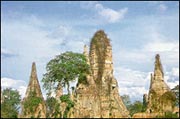 During the 18th century Burma again adopted an expansionist policy. The kings
of the Alaunghphaya Dynasty were intent on subduing the Ayutthaya kingdom, then
in cultural and artistic prime. The Burmese invaded Ayutthaya in 1765. This time Burmese caused much fear to Thais.
Burmese soldiers destroyed everything, including temples, manuscripts, and religious sculpture. After the capital fell in their hands for two years, the Burmese
effectiveness could not further hold the kingdom. Phaya Taksin, a Thai general, promoted himself to be the king in 1769. He ruled the new capital of Thonburi on the bank of Chao
Phraya River, opposite Bangkok. Thais regained control of their country and thus
scattered themselves to the provinces in the north and central part of Thailand.
Taksin eventually turn himself to be the next Buddha and was dismissed and executed by his ministers who did not approve his religious values.
During the 18th century Burma again adopted an expansionist policy. The kings
of the Alaunghphaya Dynasty were intent on subduing the Ayutthaya kingdom, then
in cultural and artistic prime. The Burmese invaded Ayutthaya in 1765. This time Burmese caused much fear to Thais.
Burmese soldiers destroyed everything, including temples, manuscripts, and religious sculpture. After the capital fell in their hands for two years, the Burmese
effectiveness could not further hold the kingdom. Phaya Taksin, a Thai general, promoted himself to be the king in 1769. He ruled the new capital of Thonburi on the bank of Chao
Phraya River, opposite Bangkok. Thais regained control of their country and thus
scattered themselves to the provinces in the north and central part of Thailand.
Taksin eventually turn himself to be the next Buddha and was dismissed and executed by his ministers who did not approve his religious values.
Thonburi Period
Thonburi was founded by a Thai general named Phraya Taksin, who was later crowned King Taksin Maharaj. After the fall of Ayutthaya to the Burmese in 1767, Thonburi, situated on the west bank of the Chao Phraya opposite what is now the City of Bangkok, became the new Thai capital.
After the shattering defeat which had culminated in Ayutthaya's destruction, the death and capture of thousands of Thais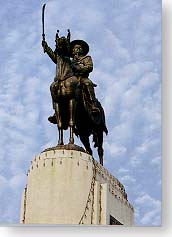 by the victorious Burmese, and the
dispersal of several potential Thai leaders, the situation seemed hopeless. It was a time of darkness and of troubles for the Thai nation. Members of the old royal
family of Ayutthaya had died, escaped, or been captured by the Burmese and many rival claimants for the throne emerged, based in different areas of the country.
But out of this national catastrophe emerged yet another saviour of the Thai state
- the half-Chinese general Phraya Taksin, former governor of Tak. Within a few
years this determined warrior had defeated not only all his rivals but also the Burmese invaders and had set himself up as king,
by the victorious Burmese, and the
dispersal of several potential Thai leaders, the situation seemed hopeless. It was a time of darkness and of troubles for the Thai nation. Members of the old royal
family of Ayutthaya had died, escaped, or been captured by the Burmese and many rival claimants for the throne emerged, based in different areas of the country.
But out of this national catastrophe emerged yet another saviour of the Thai state
- the half-Chinese general Phraya Taksin, former governor of Tak. Within a few
years this determined warrior had defeated not only all his rivals but also the Burmese invaders and had set himself up as king,
Since Ayutthaya had been so completely devastated. King Taksin chose to establish his capital at ThonBuri [ across the river from Bangkok ]. Although a
small town, ThonBuri was strategically situated near the mouth of the Chao Phraya River and therefore suitable as a seaport. The Thais needed weapons, and one
way of acquiring them was through trade. Besides, foreign trade was also needed to bolster the Thai economy, which had suffered extensively during the war with
Burma (now Myanmar). Chinese and Chinese-Thai traders helped revive the economy by engaging in maritime trade with
neighboring states, with China, and with some European nations.
King Taksin's prowess as a general and as an inspirational leader meant that all attempts by the Burmese to
re-conquer Siam failed. The rallying of the Thai nation during a time of crisis was King Taksin's greatest achievement. However, he was also interested in cultural revival, in literature and the arts. He was deeply
religious and studied meditation to an advanced level. The stress and strain of such much fighting and the responsibility of rebuilding a centralized Thai state took their
toll on the king. Following an internal political conflict in 1782. King Taksin's fellow general Chao Phraya Chakri was chosen king. King Taksin's achievements have
caused to bestow on him the epithet "The Great".
Rattanakosin Period
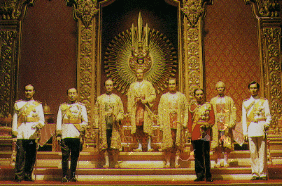 The Chakris were inaugurated on April 6, 1782 together with the coronation of Rama I or King Buddha Yot Fa Chulalok. He moved the capital across the Chao Phaya River from Thonburi to a small village known as "Bangkok" and raised up new laws
to rule the country. Under his reign, Thailand covered all areas of present day Laos and parts of Burma, Cambodia and Kedah province in Malaysia.
The Chakris were inaugurated on April 6, 1782 together with the coronation of Rama I or King Buddha Yot Fa Chulalok. He moved the capital across the Chao Phaya River from Thonburi to a small village known as "Bangkok" and raised up new laws
to rule the country. Under his reign, Thailand covered all areas of present day Laos and parts of Burma, Cambodia and Kedah province in Malaysia.
In 1809, Rama II or King Buddha Loet Lad, son of Rama I took the throne until 1824. He devoted himself to preserve the Thai literature that had remained from
Ayutthaya period and produced a new version of Ramakien or Thai Ramayana, the classical literature.
In 1824-1851, Rama III or King Nang Klao was successful in re-establishing relation and making trades with China which was necessary to meet the increasing domestic agricultural production.
Rama IV or King Mongkut (Phra Chom Klao), who reigned from 1851 to 1868 lived as a Buddhist monk for 27 years. During his monastic period, he could speak many languages such as Latin, English, and five other languages. He also studied western sciences and adopted the discipline of local Mon monk. Under his reign, he created new laws to improve the women's and
children's right, opened new waterways and roads, and created the first printing press.
Rama V or King Chulalongkorn, Rama IV's son, continued the throne from 1868 to 1910. He started to reform the tradition, legal and administrative realm by allowing officials to sit on chairs during royal audiences. Under the reign of Rama V, Thailand
developed relations with European nations and the USA. He introduced schools, roads, railways, and Thailand's first post office. He even established civil service system. In 1892, Rama V overhauled the
administration of Siam to a form of
cabinet government with 12 ministers.
In 1886, Siam lost some territory to French, Laos and British Burma accorded the foreign powers intercede. After that King Chulalongkorn declared Thailand as an independent kingdom on the 23rd of October, making this day as a national holiday. Every year this national holiday is celebrated in commemoration of this event and people lay wreaths in memory of king they called "Phra Piya Maharaj"
Rama VI or King Vajiravudh, took the throne from 1910 to 1925. During his short reign, he introduced the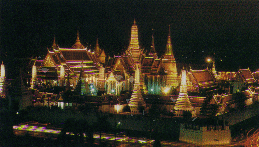 westernization to Thailand. He introduced the primary school education, Thai women were encouraged to grow their hair at a certain length.
Surnames were introduced, and football was introduced in Thailand.
westernization to Thailand. He introduced the primary school education, Thai women were encouraged to grow their hair at a certain length.
Surnames were introduced, and football was introduced in Thailand.
1925-1935 was the period of Rama VII or King
Prachadhipok, Rama VI's brother. He changed Siam's form of government from absolute monarchy to democracy. This revolution developed the constitutional monarchy along British lines, with mixed military and civilian group in power. At that time, Phibul Songkhram was a key military leader in the 1932 coup. He maintained his position and power from 1938 until the end of World War II.
Rama VIII or King Ananda Mahidol, a nephew of Rama VII, took the throne in 1935 but was assassinated under mysterious circumstances in 1946. His brother King Bhumipol Aduldej succeeded as Rama IX.
Under Rama IX's government, the country's name was officially changed from "Siam" to "Thailand" in 1946 which was defined in Thai as "Prathet Thai", the word
"Prathet" means "country" and the word "Thai" means "free" referring to the Thai races.
Copyright © 2000 - 2002 HelloSiam.com All rights reserved.